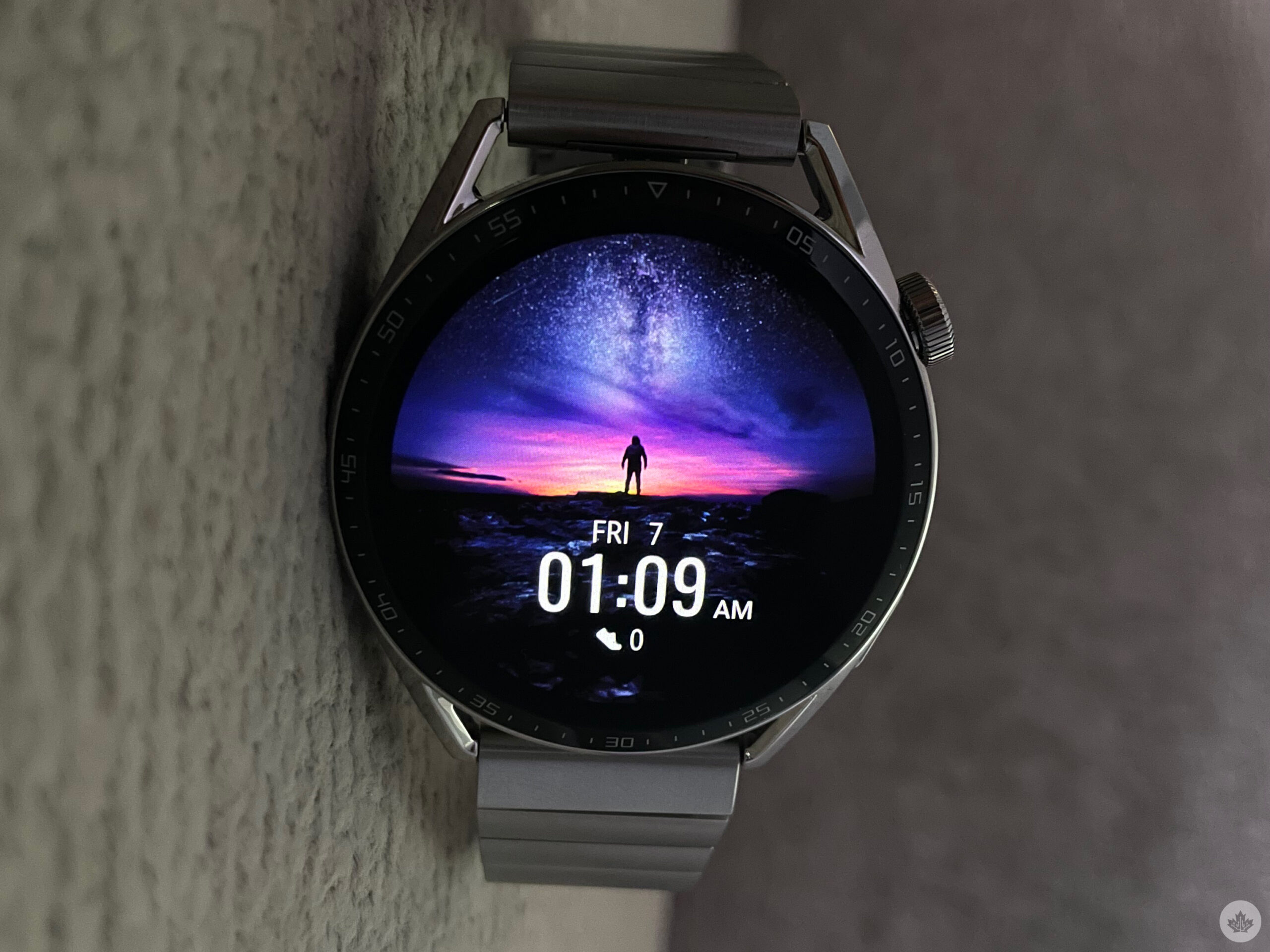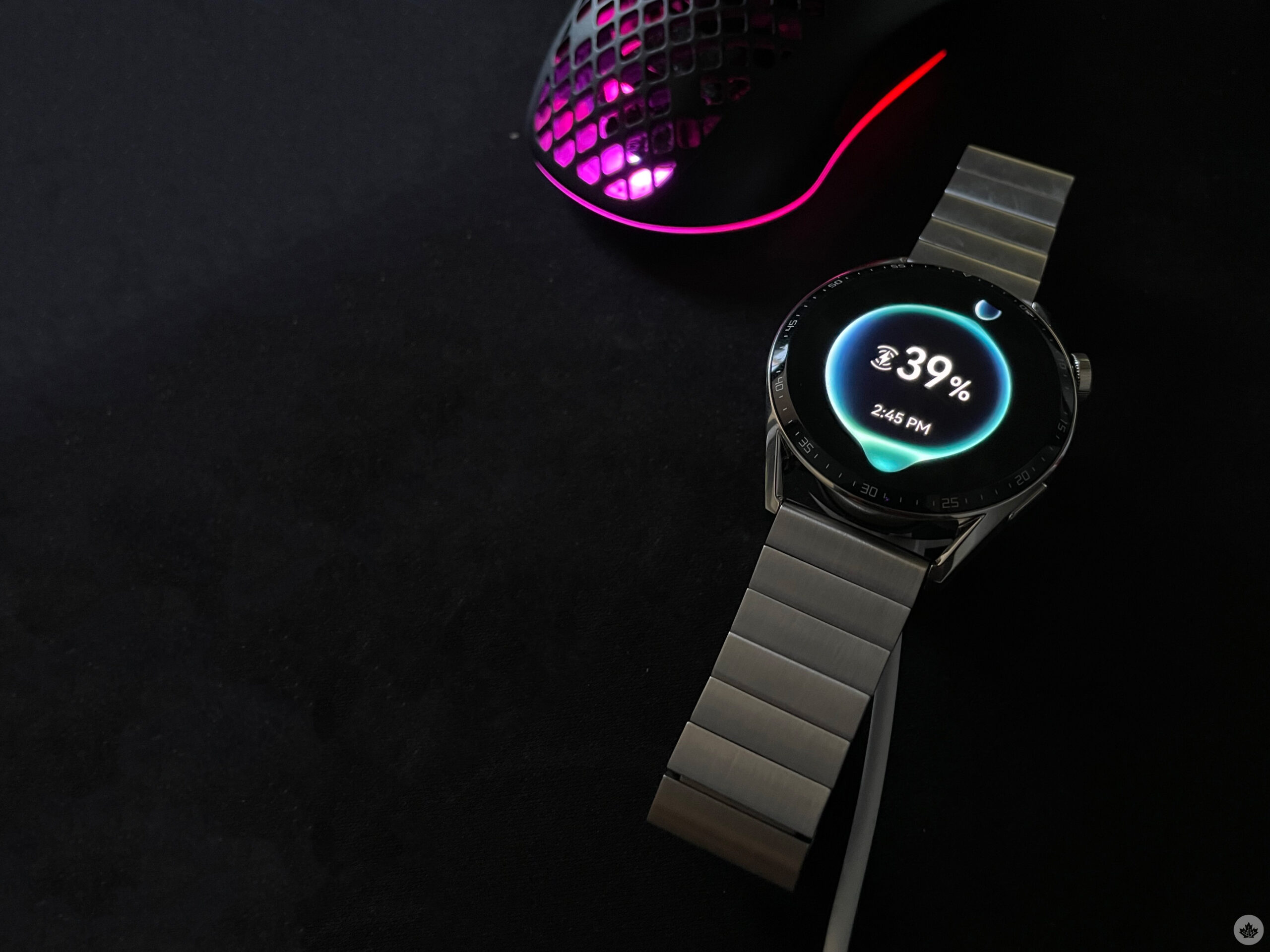Huawei’s latest Watch GT 3 is a spectacle to look at.
With its stainless steel frame and softly curved bezels that blend into an overall polished body, the watch screams premium while coming in at a modest price of $328.
It features great battery life and several health and fitness monitoring features but lacks what many consider to be pivotal to the user experience: a familiar operating system.
The watch I’m using is the 46mm variant. Right after unboxing, I realized that the ‘Stainless Steel’ band that comes with the watch was a little too big for my wrist.
However, each of the band’s links feature a slidable slot-like contraption that allows you to remove or add links according to your needs. After removing two links, the watch fit my wrist perfectly. I emphasize it fitting snug because the majority of smart health and fitness features that the Watch GT 3 offers require you to have it tight on your wrist.

The watch weighs in at about 55g with the strap, though it doesn’t feel heavy on the wrist, and wearing it for long durations didn’t cause any discomfort.
The huge 1.43 inches AMOLED colour screen is the watch’s main attraction and features very responsive touch support. When off, the screen perfectly blends with the black bezels, offering a uniformed one-piece look, though it does attract fingerprints and smudges.
The bezels sport an actual clock-like look with minutes engraved into the body in a clockwise pattern, making it easier for you to check the time (if you don’t use the digital time watch face).
The polished edges of the watch frame maintain the look all the way to the rear end where the sensors sit. This is something that not all watch manufacturers do and definitely shows that Huawei paid close attention to the wearable’s design.
On the right, the watch sports a crown that can be tapped once to select whatever option/feature/setting you’re hovering over, and can also be rotated to scroll up/down or to zoom in/out. Right below the crown sits a physical button that by default takes you directly to the ‘workout’ section, though you can customize it to navigate to where you want.
As mentioned, I’m using the Stainless Steel strap, however, you can also go for the ‘Black Fluoroelastomer’ strap or the ‘Brown Leather’ strap, depending on your needs. I felt that the stainless steel band isn’t suitable when you’re out running and want to track your fitness. Similarly, it isn’t fun to wear a stainless steel band all night if you want to use the watch for sleep tracking.
In the box, you’ll receive three extra stainless steel links, in case you want to make the strap a tad bit bigger, along with a wireless charging cradle.

Setting up the watch right out of the box is easy. As with all Huawei wearables, you’ll need to download the Huawei Health app for iOS (iOS 9.0 and later) or Android (Android 6 or later). I already had the app installed since I’ve been using Huawei’s Band 6 fitness tracker for a while now.
Issues regarding pairing Huawei Wearables are rampant. While iOS pairing is a breeze, connecting the watch to an Android device always resulted in several failed attempts. An easy fix is instead of downloading the Huawei Health app from the Google Play Store, download it from the Huawei App Gallery. This fixed the issue for several other users and me.
The watch runs on Huawei’s in-house and easy-to-use HarmonyOS 2.1. The user interface is straightforward and I’m sure anyone can get the hang of it on the first day of use. That, however, doesn’t mean that the watch lacks advanced features.
Primary health features, including heart rate monitoring, sleep tracking, stress monitoring and skin temperature monitoring are all available on the watch and work without issues.
It’s worth noting that some features, like skin temperature monitoring, aren’t available on other more expensive wearables, including the latest Apple Watch Series 7 and Samsung Galaxy Watch 4.
The only feature I did have a problem with was the SpO2 monitoring. The watch is able to monitor your blood oxygen saturation levels in the background throughout the day, but whenever I try to spot check it manually, the watch gives me an error that says, “Make sure the screen is facing up, then try again.”
I’ve tried resetting the watch, taking it off and wearing it again, but whenever I try to monitor my SpO2, I’m greeted with the same error message. In total, the feature has only worked on two occasions, which isn’t something I’m pleased with.
While most of the results seem accurate and translate over to the Band 6, the Huawei app mentions that the watch is not designed to be a medical device and that results should not be used for medical diagnosis or treatment. That said, the app does offer a detailed breakdown of all your health results, including information regarding whether you’re on the healthy side or not.
The heart rate monitoring section gives you a breakdown of your heart rate range, average resting heart rate, and a graph that summarizes your daily, weekly, monthly and annual heartbeat patterns.
Similarly, sleep tracking breaks down the data into time spent in ‘Deep Sleep,’ ‘Light Sleep,’ and also tracks when you wake up in the middle of the night.

The watch tracks your heart rate to monitor any spike in your stress levels throughout the day. You can check your stress data directly on the watch or in the app, which presents the data on a graph split into daily, weekly, monthly, and yearly statistics. You’ll get a daily stress score as well as a breakdown of your stress levels at various times throughout the day.
According to Huawei, scores between 1-29 classify as relaxed, 30-59 classify as normal, anything between 60-79 is medium, and 80-99 is considered high. My score for the past week was 37, which is in the normal range, though I would like it to sit close to 1-29, in the relaxed range.
If you’re someone with anxiety or high-stress levels, the watch can track the data and help you understand what time of the day your stress levels are the highest. In addition, built-in breathing exercises can help you calm down as well.
Apart from health monitoring, the watch supports several fitness tracking features, more than 100 to be precise. These include outdoor run, indoor run, outdoor walk, indoor walk, cycling, swimming, jump rope, skiing, rower and a lot more.
A new feature introduced with the watch is ‘Running Index’, which evaluates your running heart rate, pace, distance and frequency to provide you with a breakdown of your running ability and can help you improve your running performance.
Features aside, the watch is exceptionally responsive to touch and works without any noticeable delay. It transfers data over to the Huawei Health app in real-time and delivers notifications from your phone to the watch, also in real-time.
It features a music player which can play songs directly from the watch’s speaker and the same speaker works when you want to make a call from the watch. While it isn’t the loudest, the watch can be paired with wireless earbuds for calls or to listen to music.

The Watch GT 3 supports raise-to-wake, which always works without error, though you can also enable the always-on display mode, which will drain the battery but keep the screen on at all times.
The wearable includes expected functionality like a flashlight, a ringer for you to find your smartphone, alarms and reminders as well.
Battery Life
Huawei says that the Watch GT 3 offers battery life of about 14 days for typical usage. What is typical use though?
According to the company, “30 minutes of Bluetooth calling every week, 30 minutes of music playing every week, heart rate monitoring enabled, Huawei TruSleep enabled for sleeping, 90 minutes of working out every week (GPS enabled), message notifications enabled (50 SMS messages, 6 calls, and 3 alarms a day), screen is turned on 200 times a day,” classifies as typical usage.

Naturally, my usage wasn’t typical. I kept the watch at full brightness, with always-on display enabled, full nights of sleep tracking and I used multiple health-based features that make use of battery-draining sensors throughout the day, every day. The watch lasted exactly about nine days before running out of juice.
In my opinion, considering the colour AMOLED touch display was always on, and the watch was continuously paired to my phone and delivering its notifications, nine days is more than I can ask for. And if the watch dies when you need it, an hour of charging should fuel it up to about 50-60 percent.
Also, considering the fact that in normal everyday use, you won’t have all the tracking features running at once, I can easily see the watch exceeding Huawei’s 14-day battery life claim. Impressive.
While Huawei’s in-house HarmonyOS is one of the reasons why the watch doesn’t lag or have choppy animations, it also restricts you from downloading some of your favourite apps. At the moment, you can only download a handful of apps that are available on Huawei Health.
Additionally, the in-watch music player doesn’t let you stream from the likes of Spotify or Apple Music, and instead, you have to manually download music on your smartphone and sync it through the Health App. What makes this even worse is that the syncing feature is only available for Android users, while iOS users are left in the dust.
And while the wearable did deliver notifications from my phone in real-time, It does not support notification interaction, so you’ll have to pick up your phone to reply to messages or interact with notifications.
The speaker is decent at most, so don’t expect top-notch call audio quality when you’re out and about.
My recommendation
I’ll be straightforward; the Huawei Watch GT 3 does have several flaws. It lacks third-party app support and restricts iOS users from enabling certain features, like syncing music. Its speaker is decent at max and some features like Sp02 tracking gave me a hard time. That said, I don’t see these flaws affecting the everyday user who just wants a trustworthy smartwatch.

The Huawei Watch GT 3 has exceptional health and fitness tracking features, is waterproof, has a bright coloured AMOLED touch screen display that is super responsive, a hard-to-drain battery that can recharge quickly and wirelessly, and to top it all off, it looks beautiful.
The Huawei Watch GT 3 46mm is available to order at Amazon, Costco, Canada Computers and Visions Electronics for $328.99.
The Huawei Watch GT3 is also available in a lighter 42mm variant that sports a smaller 1.3-inch display and different straps. Learn more about the differences between the two variants here.
MobileSyrup utilizes affiliate partnerships. These partnerships do not influence our editorial content, though we may earn a commission on purchases made via these links that helps fund the journalism provided free on our website.

